Today, if you look hard enough, you can still find the “signatures” of long-defunct railroads that served Fort Worth after the city finally became the rail hub that B. B. Paddock’s “tarantula map” had predicted in 1873 when the city had, to that date, exactly zero railroads.
 But by 1902 Fort Worth was served by nine railroads—enough to equip Paddock’s “tarantula” with eight legs and one to spare.
But by 1902 Fort Worth was served by nine railroads—enough to equip Paddock’s “tarantula” with eight legs and one to spare.
The locomotives and railroad cars that traveled the tracks of those ninw railroads are gone. But railroads (and railroad bridge companies) signed their work: They displayed their names on their bridges and overpasses. Thus, you would see “M-K-T” or “T&P” on a bridge or overpass the same as you would see “REO” on a motor car or “BTT” on Thurber bricks.
Here are some surviving signatures from Cowtown’s iron age (all newspaper ads are from 1901 and 1902):

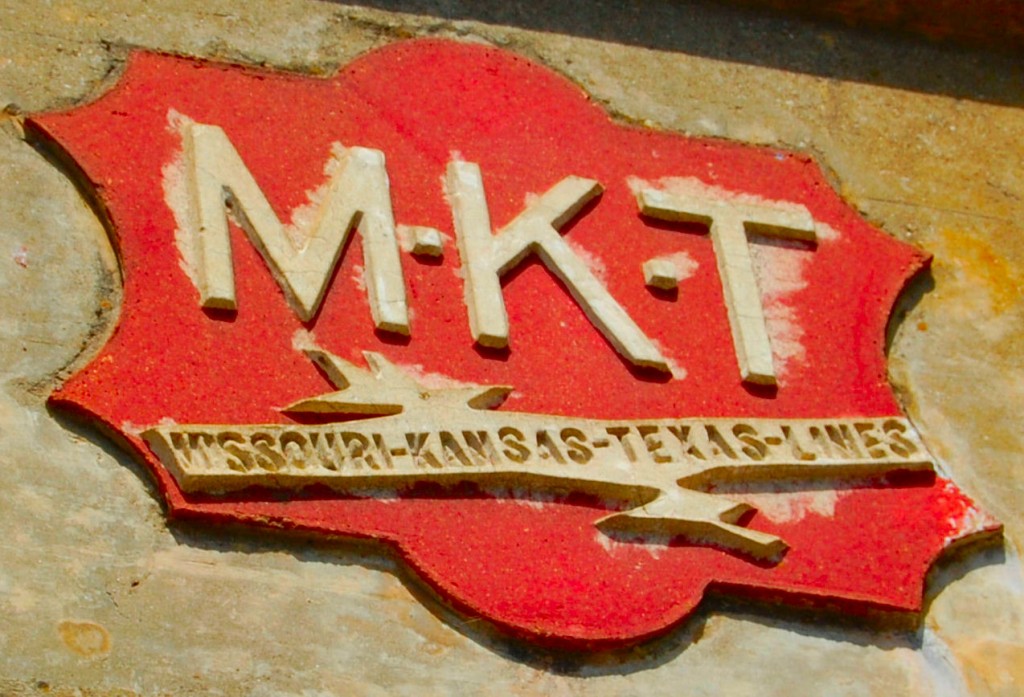
The best-preserved railroad badge I have found so far is on the Missouri-Kansas-Texas (Katy) overpass (1931) on Morningside Drive north of Katy Lake. The Katy was absorbed into Union Pacific.
 This faded Katy badge is on the overpass over the same track but farther south on Seminary Drive.
This faded Katy badge is on the overpass over the same track but farther south on Seminary Drive.
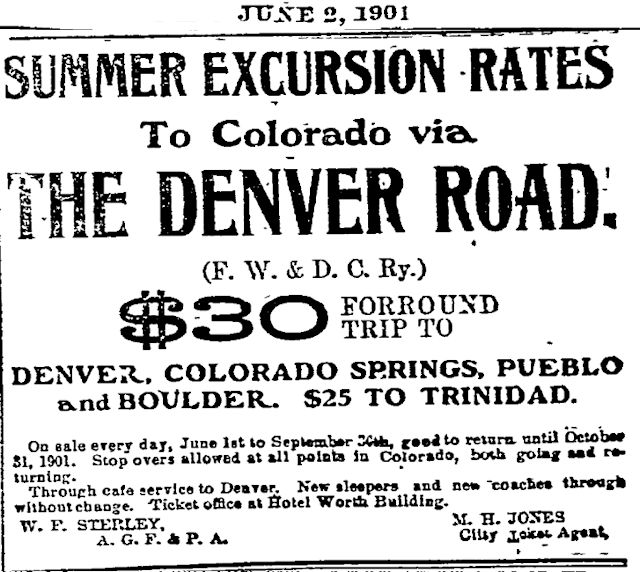
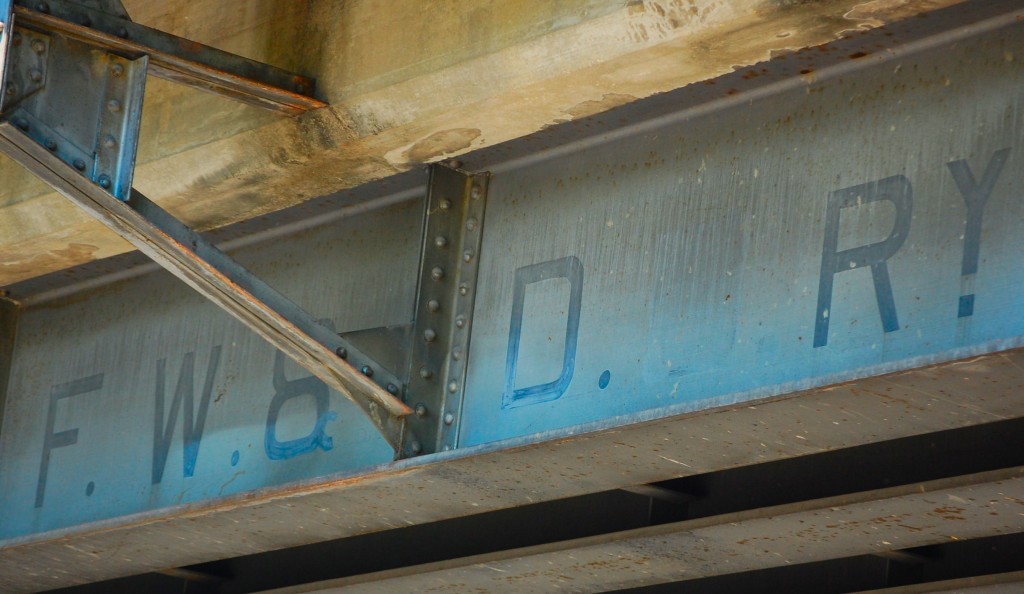 When the Stockyards and packing plants were operating, rail traffic was heavy on the North Side. A half-dozen spur tracks connected the packing plants to the main tracks of Santa Fe and Rock Island. This Fort Worth & Denver bridge is on Northeast 28th Street. The FW&D began serving Fort Worth in 1882, was merged into Burlington Northern, which became Burlington Northern Santa Fe. The Fort Worth & Denver was known as “the Denver Road.” In the days before the automobile, people often referred to railroads as “roads” and to streetcars as “cars.”
When the Stockyards and packing plants were operating, rail traffic was heavy on the North Side. A half-dozen spur tracks connected the packing plants to the main tracks of Santa Fe and Rock Island. This Fort Worth & Denver bridge is on Northeast 28th Street. The FW&D began serving Fort Worth in 1882, was merged into Burlington Northern, which became Burlington Northern Santa Fe. The Fort Worth & Denver was known as “the Denver Road.” In the days before the automobile, people often referred to railroads as “roads” and to streetcars as “cars.”
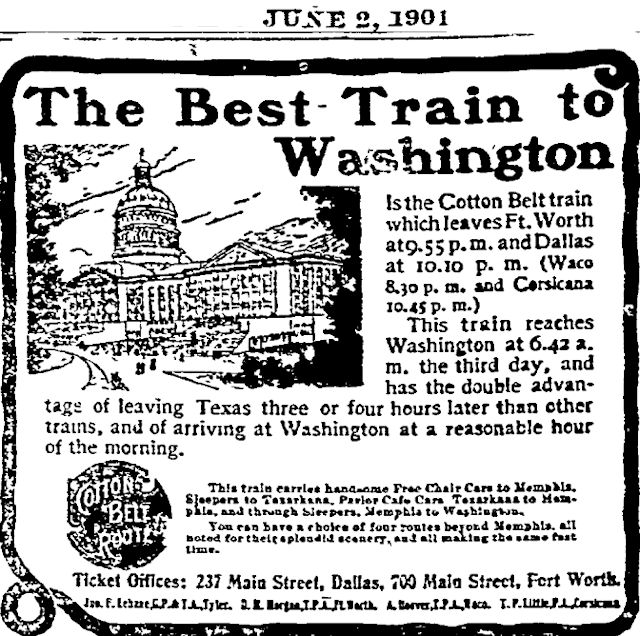
 Also on Northeast 28th Street is a bridge of the Cotton Belt line. Why “Cotton Belt”? Because one of the railroad’s early major investors, James W. Paramore, owned the St. Louis Cotton Compress Company and was looking for a way to ship cotton.
Also on Northeast 28th Street is a bridge of the Cotton Belt line. Why “Cotton Belt”? Because one of the railroad’s early major investors, James W. Paramore, owned the St. Louis Cotton Compress Company and was looking for a way to ship cotton.
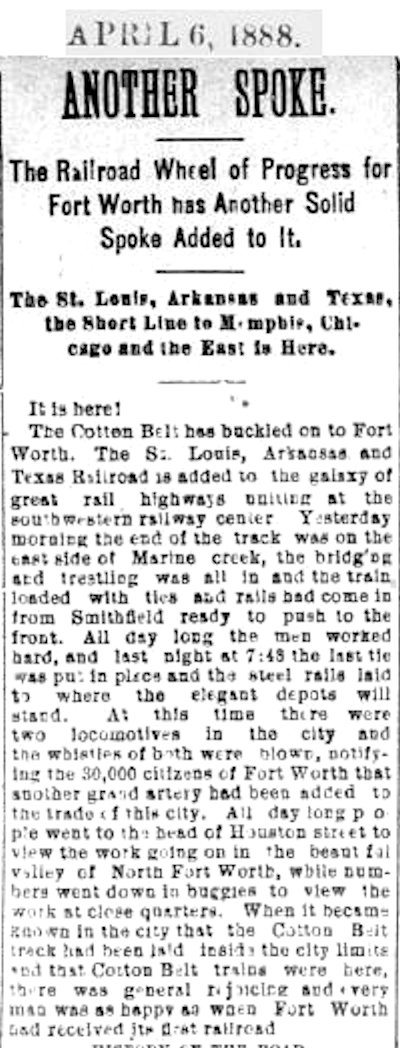 The Cotton Belt had first reached Fort Worth in 1888 as the “St. Louis, Arkansas and Texas.” (The genealogy of a railroad is seldom simple.)
The Cotton Belt had first reached Fort Worth in 1888 as the “St. Louis, Arkansas and Texas.” (The genealogy of a railroad is seldom simple.)
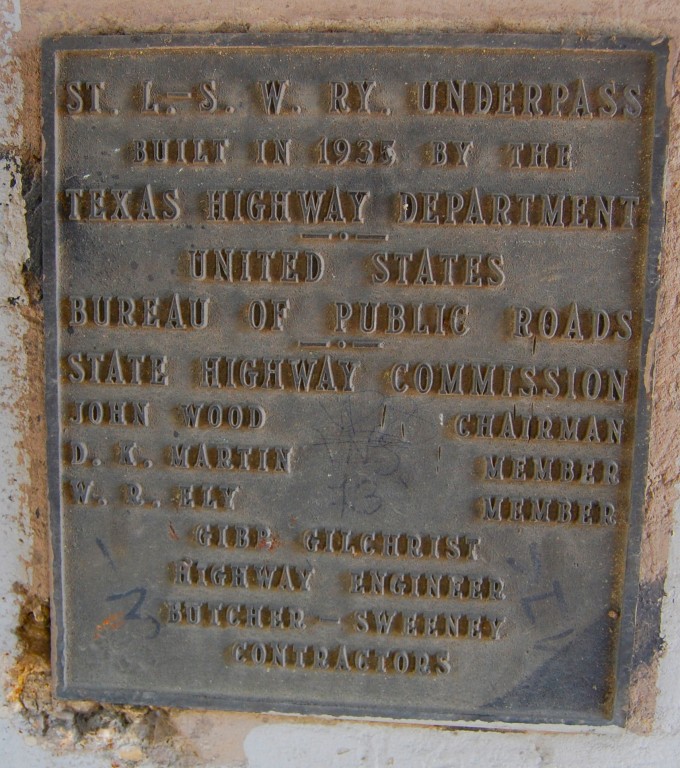 Plaque on the Cotton Belt underpass. The Cotton Belt railroad was also known as the “St. Louis-Southwestern Railway of Texas.”
Plaque on the Cotton Belt underpass. The Cotton Belt railroad was also known as the “St. Louis-Southwestern Railway of Texas.”
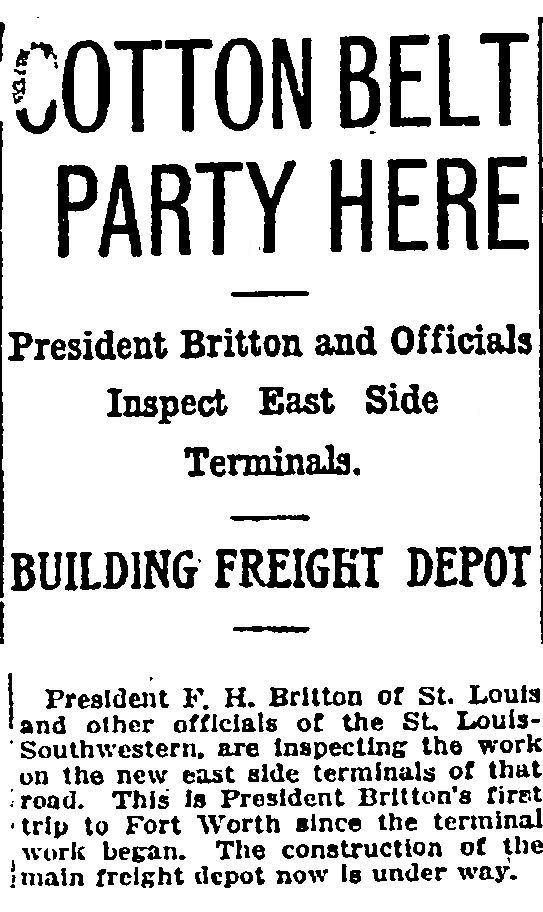 In 1915 the railroad built a freight depot and office building on the eastern edge of downtown. This Star-Telegram clip is from October 12, 1914.
In 1915 the railroad built a freight depot and office building on the eastern edge of downtown. This Star-Telegram clip is from October 12, 1914.
The Cotton Belt eventually was absorbed into Union Pacific. DART now owns some of the local Cotton Belt track, and the TEXRail commuter line between downtown Fort Worth and the airport will include some of that track.
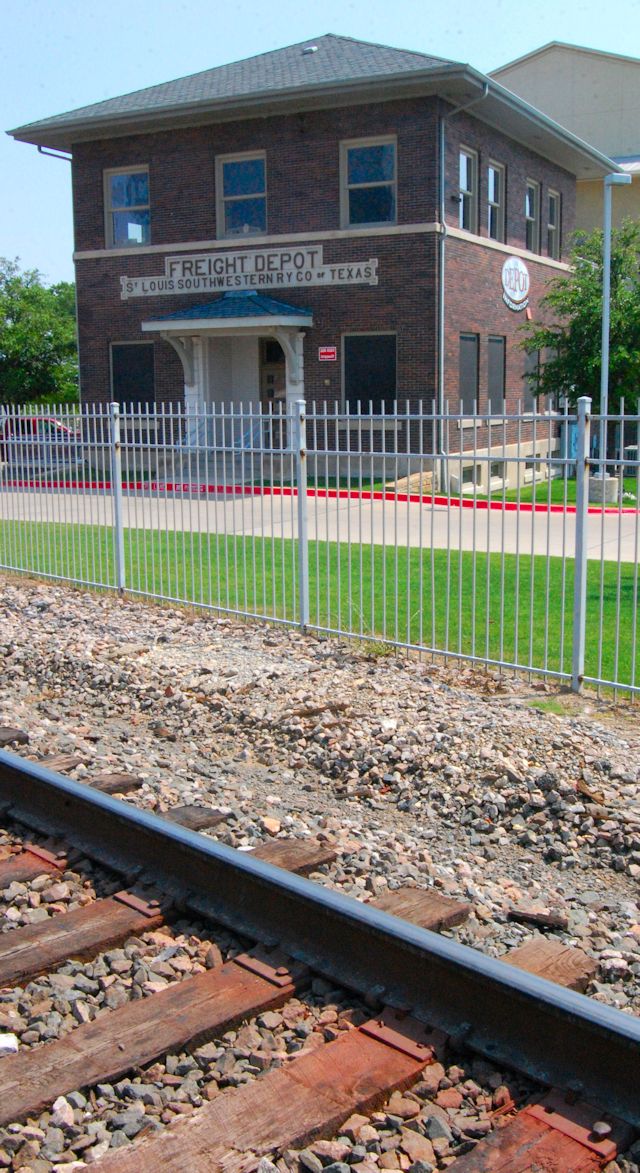 The Cotton Belt freight depot was torn down and replaced by the Cotton Depot Apartments a few years ago. But the office building was spared and serves as the apartment complex’s office.
The Cotton Belt freight depot was torn down and replaced by the Cotton Depot Apartments a few years ago. But the office building was spared and serves as the apartment complex’s office.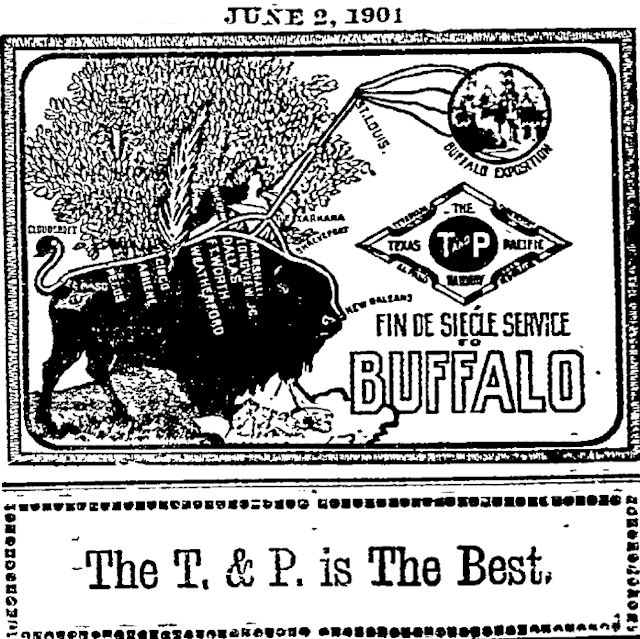
 Texas & Pacific bridge (1929) over Collard Street in east Fort Worth. The T&P, of course, became the first leg on Paddock’s tarantula map on July 19, 1876. T&P merged with Missouri Pacific, which was bought by Union Pacific.
Texas & Pacific bridge (1929) over Collard Street in east Fort Worth. The T&P, of course, became the first leg on Paddock’s tarantula map on July 19, 1876. T&P merged with Missouri Pacific, which was bought by Union Pacific.
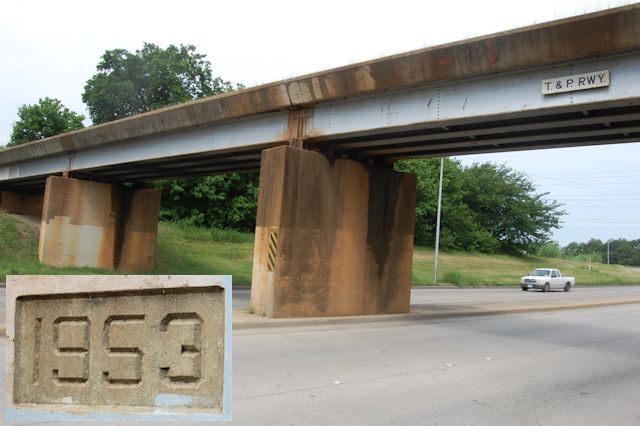 Similar signature on a 1953 bridge over Northside Drive.
Similar signature on a 1953 bridge over Northside Drive.
 The Jennings Avenue underpass (1931) just south of downtown. Inset shows the Texas & Pacific signature in the upper-left corner of each side of the underpass.
The Jennings Avenue underpass (1931) just south of downtown. Inset shows the Texas & Pacific signature in the upper-left corner of each side of the underpass.
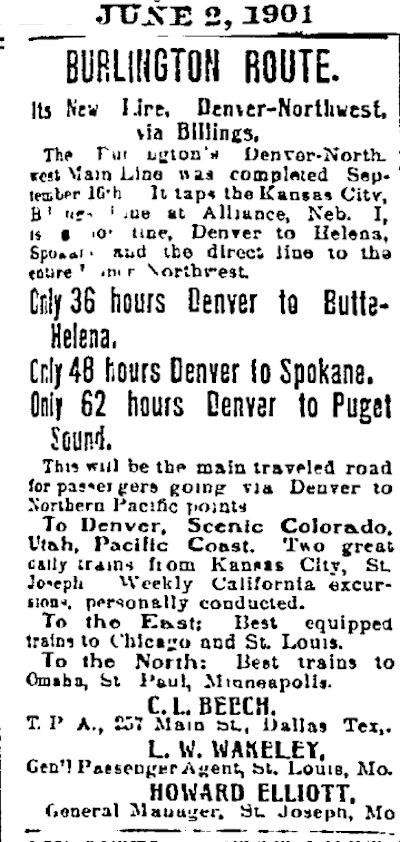
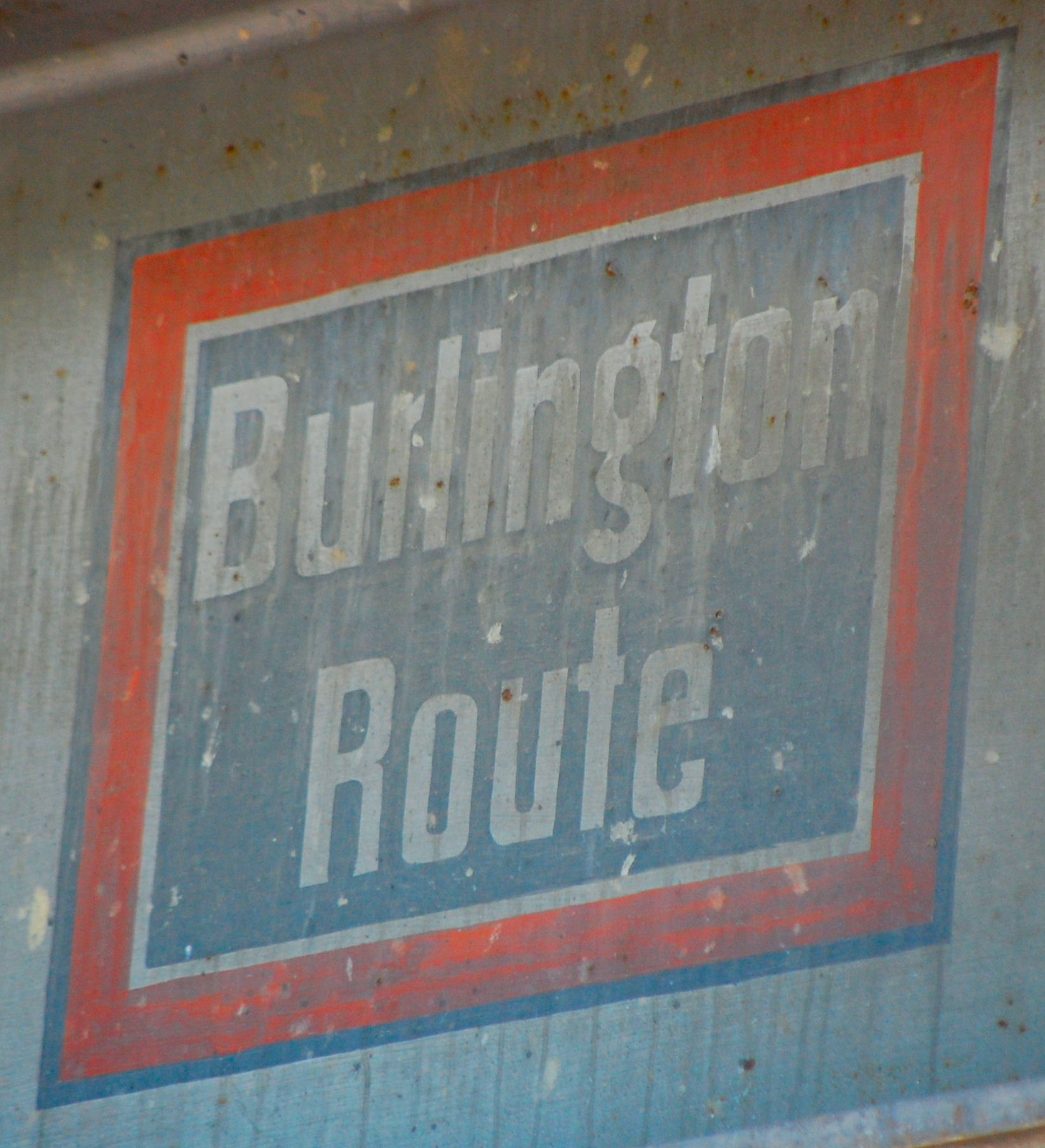 On Northeast 28th Street. Burlington Route (officially “Chicago, Burlington and Quincy Railroad”) acquired the Denver Road in 1908. The Burlington Route is now Burlington Northern Santa Fe, which, like AARP, prefers to be referred to by its initials only. BNSF is headquartered in Fort Worth and is the full-scale train set of little Warren Buffett.
On Northeast 28th Street. Burlington Route (officially “Chicago, Burlington and Quincy Railroad”) acquired the Denver Road in 1908. The Burlington Route is now Burlington Northern Santa Fe, which, like AARP, prefers to be referred to by its initials only. BNSF is headquartered in Fort Worth and is the full-scale train set of little Warren Buffett.
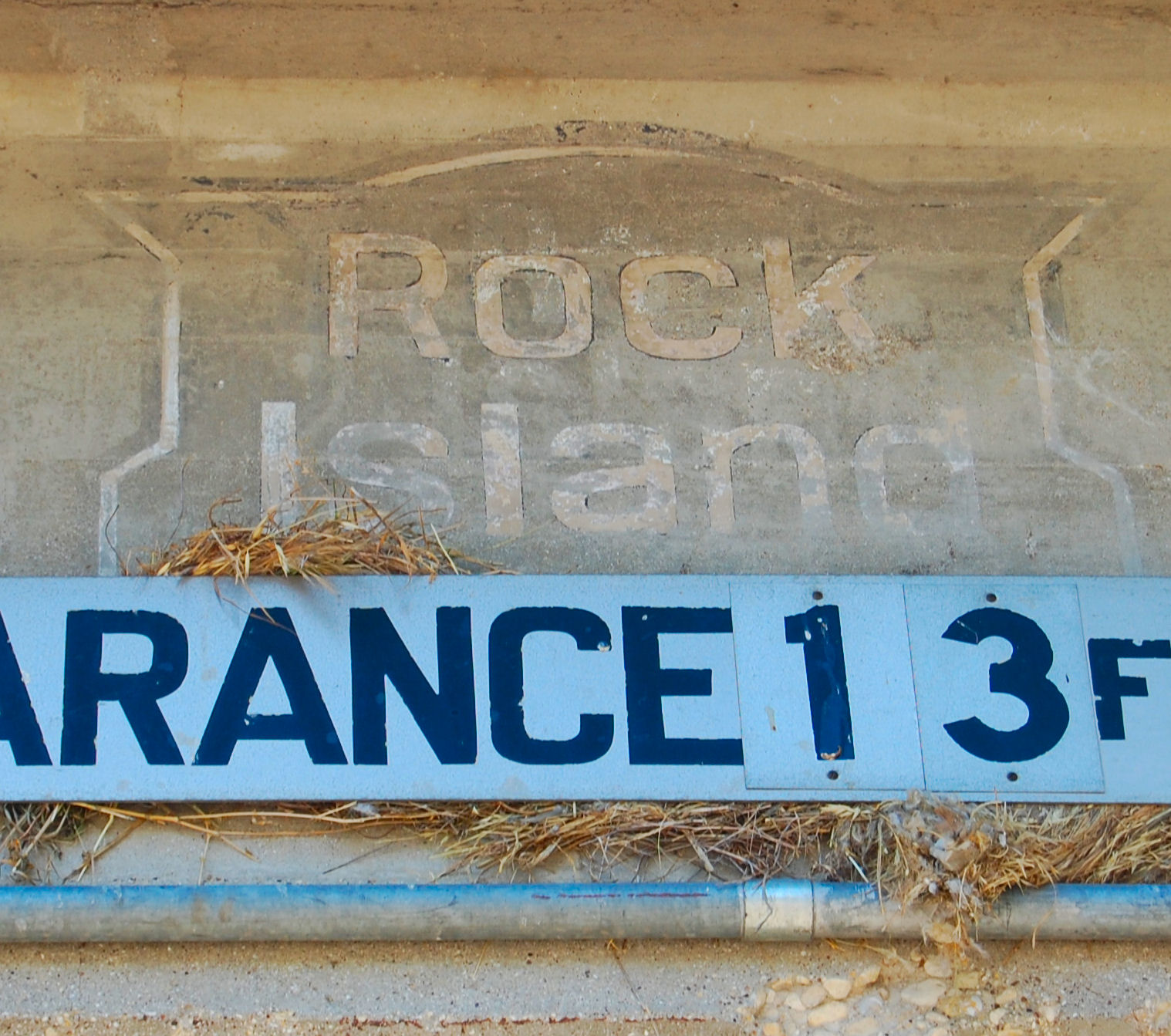 On East 4th Street. The Rock Island line took to the rails in 1852, arrived in Fort Worth in 1893 from the north.
On East 4th Street. The Rock Island line took to the rails in 1852, arrived in Fort Worth in 1893 from the north.
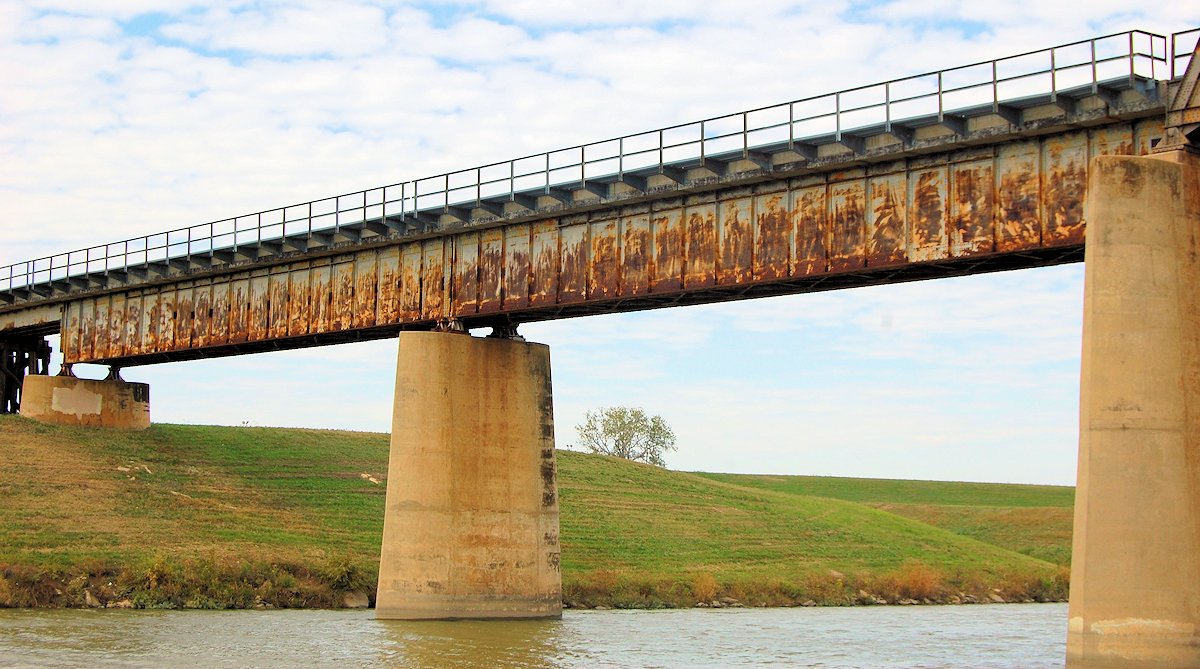 This is a section of the Rock Island bridge over the Trinity River east of downtown, built in 1903. In 1980 the Rock Island line reached the end of “a mighty good road.”
This is a section of the Rock Island bridge over the Trinity River east of downtown, built in 1903. In 1980 the Rock Island line reached the end of “a mighty good road.”
But who built this bridge?
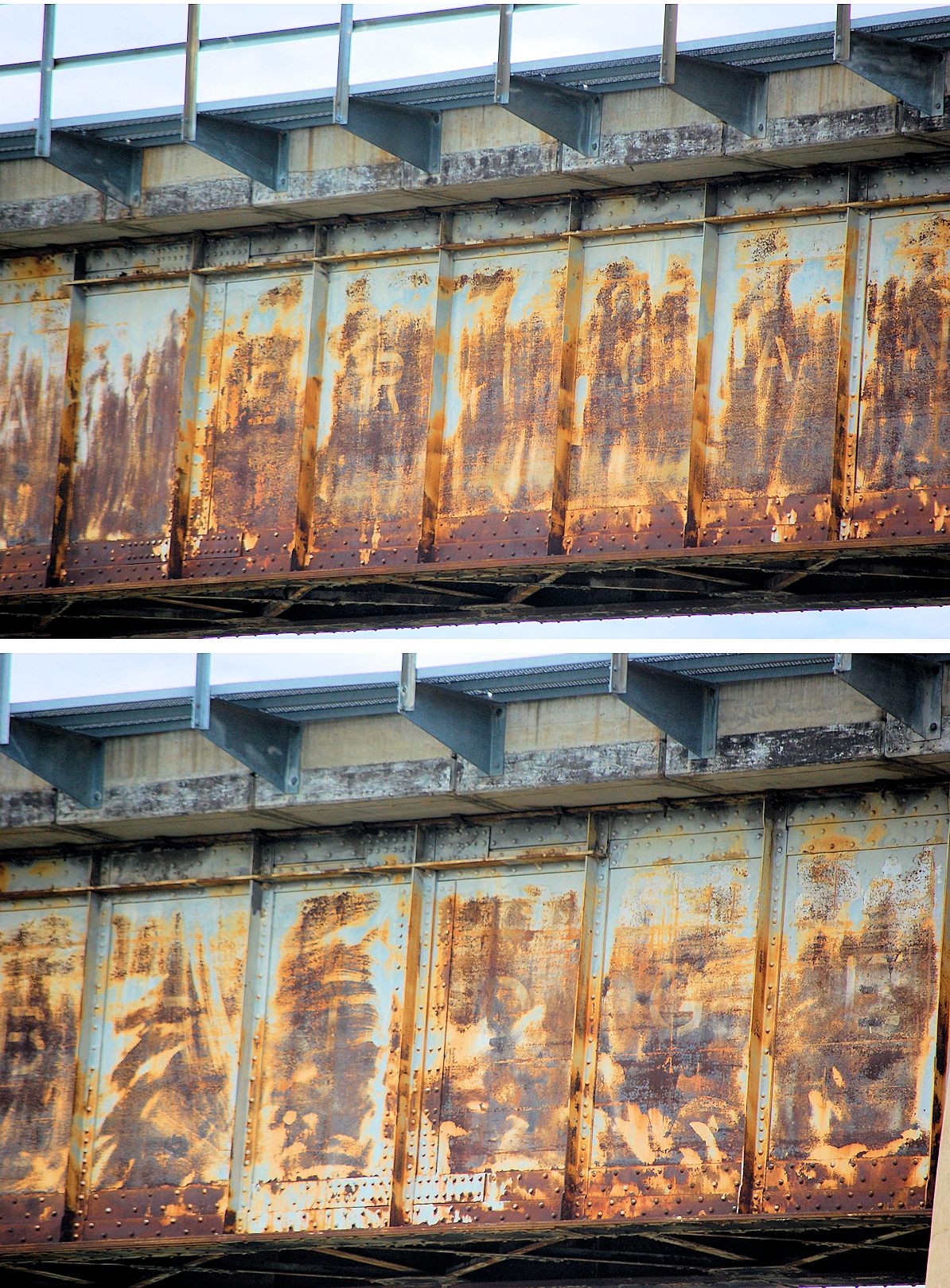
If you look past the decades of rust and graffiti, you can see the signature. There is a light-colored capital letter on each vertical side panel: (top) AMERICAN (bottom) BRIDGE. The American Bridge Company, founded in 1900, built many of America’s best-known (and longest) bridges as well as these buildings: Sears Tower and John Hancock Center (Chicago); Empire State Building, Pan-Am Building, Chrysler Building, Woolworth Building, Flatiron Building (New York City); Boeing 747 Assembly Building (Everett, Washington); Astrodome (Houston).
 Much easier to read is this badge of the American Bridge Company on the Santa Fe bridge (1904) over Trail Lake Drive in southwest Fort Worth. Santa Fe, like Burlington, is now BNSF.
Much easier to read is this badge of the American Bridge Company on the Santa Fe bridge (1904) over Trail Lake Drive in southwest Fort Worth. Santa Fe, like Burlington, is now BNSF.
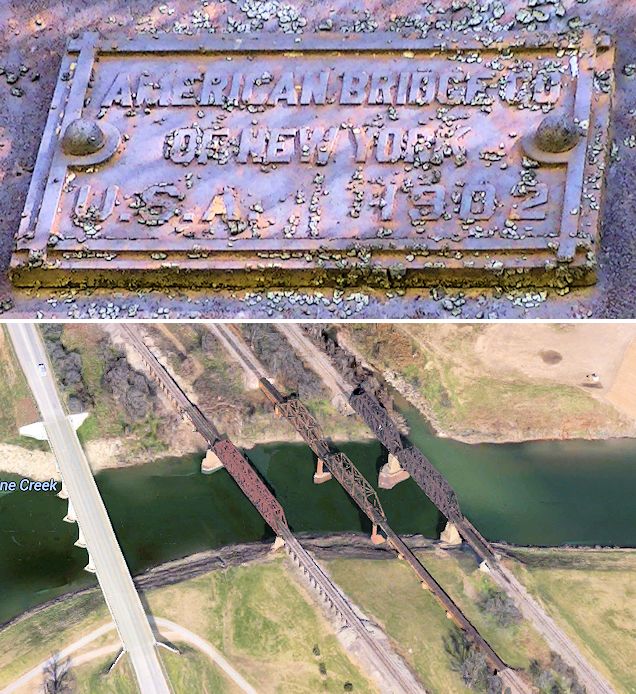 Another American Bridge Company badge is on a 1902 trestle of the middle of the “Three Sisters” tracks that cross the Trinity River east of Samuels Avenue. The original railroads were, from the left, Santa Fe, Fort Worth & Denver, and Rock Island.
Another American Bridge Company badge is on a 1902 trestle of the middle of the “Three Sisters” tracks that cross the Trinity River east of Samuels Avenue. The original railroads were, from the left, Santa Fe, Fort Worth & Denver, and Rock Island.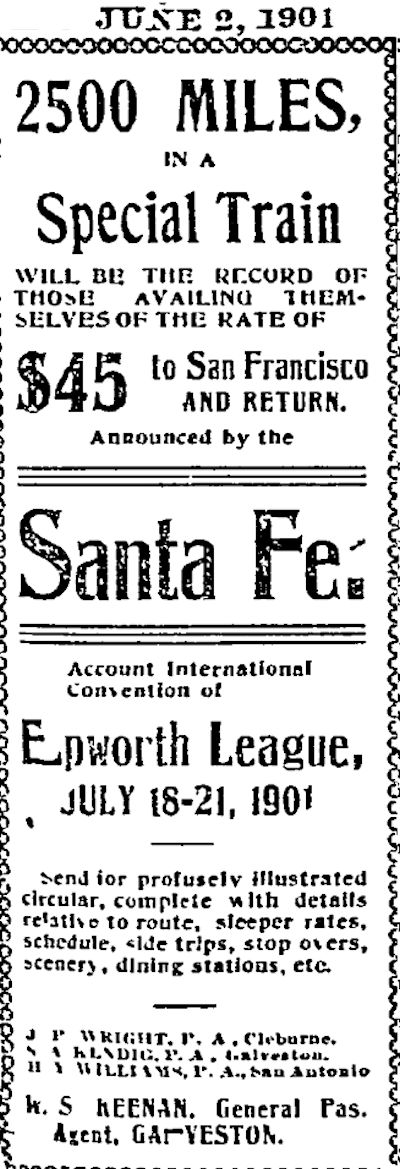
 On East 3rd Street.
On East 3rd Street.
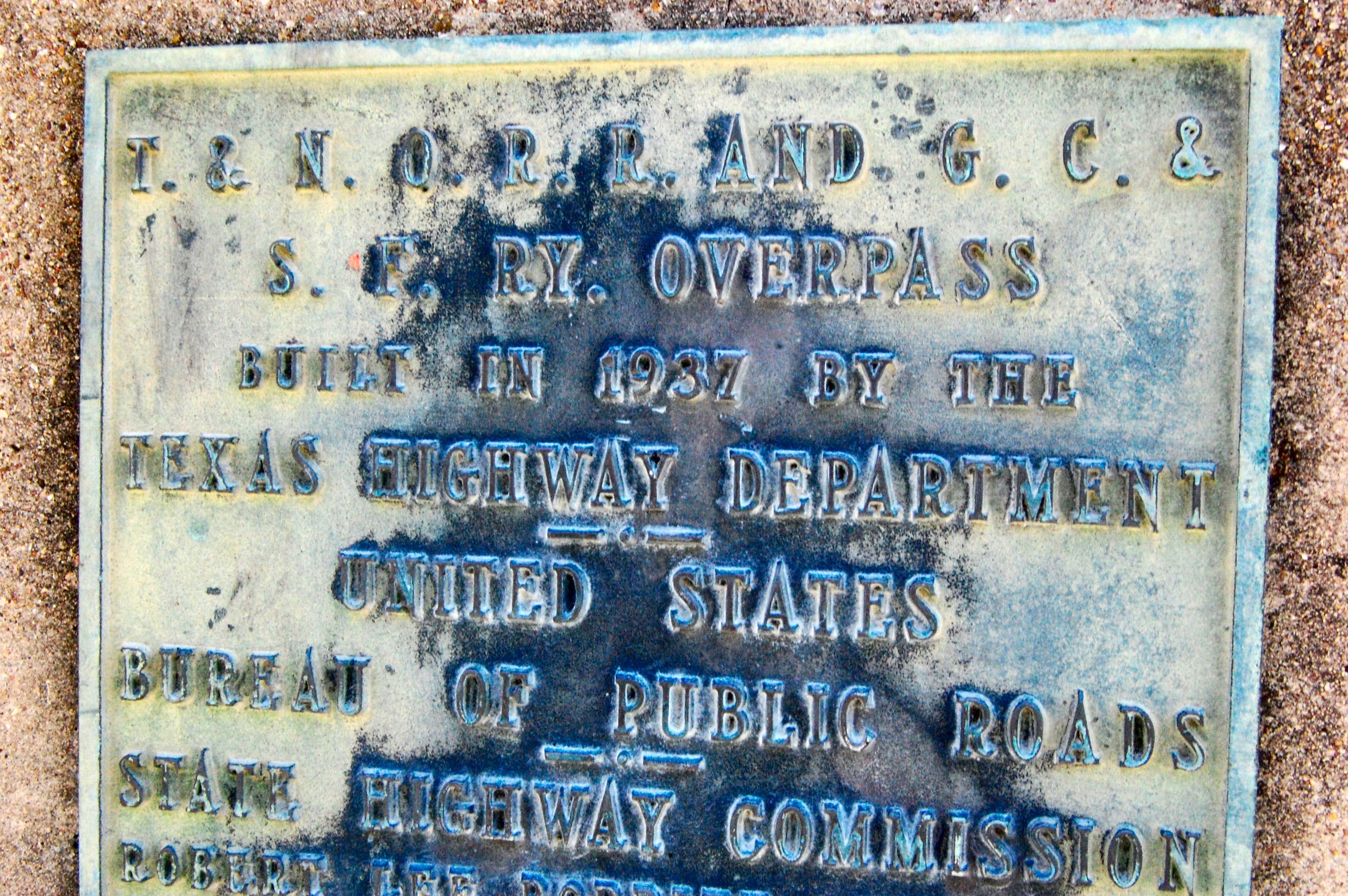 The South Main Street overpass was built in 1937 for the Texas & New Orleans and the Gulf, Colorado, and Santa Fe railroads. In 1934 the Texas & New Orleans railroad acquired the Houston & Texas Central, which served Fort Worth. In turn, in 1961 Southern Pacific absorbed the Texas & New Orleans. In 1995 Santa Fe merged with Burlington Northern to form BNSF.
The South Main Street overpass was built in 1937 for the Texas & New Orleans and the Gulf, Colorado, and Santa Fe railroads. In 1934 the Texas & New Orleans railroad acquired the Houston & Texas Central, which served Fort Worth. In turn, in 1961 Southern Pacific absorbed the Texas & New Orleans. In 1995 Santa Fe merged with Burlington Northern to form BNSF.
End of the line. Everybody off.
Posts About Trains and Trolleys






I’ve just noticed your website that has some discussion of early Cotton Belt activities in Fort Worth. There seems to be confusion on the part of the commentators on this subject regarding a “Fifth Street station” which they locate near the old power plant on North Main, down the bluff on the back side of the court house. It seems possible that two “Fifth St” locations existed for Cotton Belt operations in Fort Worth, the one just mentioned and another one on E. Firth St. where their freight terminal location was. These were served independently by separate tracks running southward from the Tower 60 location near the stockyards. When we first moved to Fort Worth about 1950, the Cotton Belt had two freight spur switching operations in the North Main river bottom industrial area. One ran down Commerce St. east of Main, the other ran down Houston St. west of N. Main. Any comments or opinions?
Good question. Fort Worth’s railroad history makes my brain hurt. The Cotton Belt definitely had a freight depot on East 5th downtown. As you say, the Cotton Belt also had an earlier yard with at least a freight depot west of North Main. After the city annexed that area, any reference to a 5th Street there should be Northwest 5th” to distinguish it from the East 5th Street downtown. Likewise, as for a spur east of Main on North Commerce, that would cross “Northeast 5th Street.” Here is a good post by the late Pete Charlton on the yard west of North Main. FWIW, the 1907 city directory lists the Cotton Belt freight depot at North Houston and 2nd Street in North Fort Worth, which was a separate city.
Two observations on yet another excellent post.
The Cotton Belt logo was based on a “gin saw”, an important part of any early day cotton gin operation. It’s not a cotton boll. The Cotton Belt’s gin saw should not be confused with the Missouri Pacific’s logo which was based on a “buzz saw” used in lumber operations.
Second, although the rails of the Fort Worth & Denver City did not actually reach into downtown until 1890 following the construction of the Fort Worth & Denver Terminal Railroad, they had operated from Hodge Junction beginning in 1882. At Hodge they made connections with the Texas & Pacific and later gained trackage rights. Since Hodge is for all basic purposes now part of Fort Worth proper the 1882 date could probably be also considered for when they started operations in the immediate Fort Worth area.
Thanks, Steve. I have made those corrections.
Lifelong Ft. Worth railroader Walter “Smokey” Darr recalled for me the haze of smoke that once hung over the city when some railroads were still burning coal in the early 1900s.
Another great article! I recently visited the Cotton Belt Depot Museum in Tyler, and I highly recommend it to everyone!
Thanks, Scott. Our railroad history is fascinating. I wish I could see, hear, smell, and taste what Cowtown was like during its Iron Age.